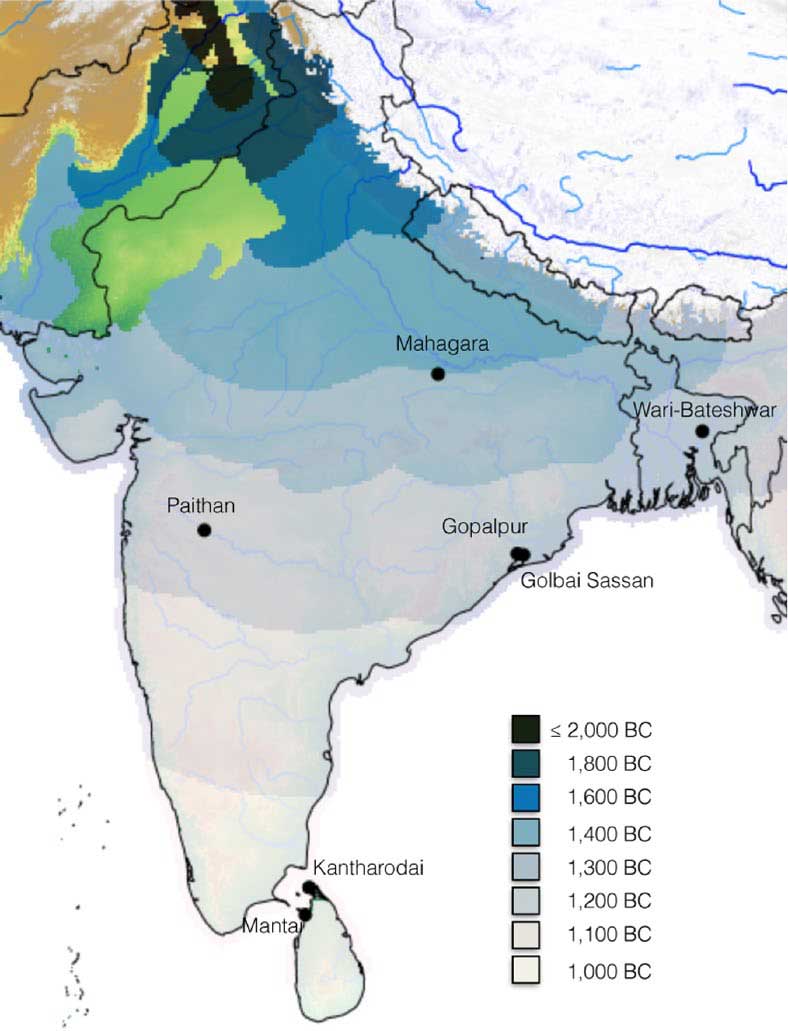New paper (behind paywall), A tale of two rice varieties: Modelling the prehistoric dispersals of japonica and proto-indica rices, by Silva et al., The Holocene (2018).
Interesting excerpts (emphasis mine):
Materials
Our empirical evidence comes from the Rice Archaeological Database (RAD). The first version of this database was used for a synthesis of rice dispersal by Fuller et al. (2010), a slightly expanded dataset (version 1.1) was used to model the dispersal of rice, land area under wet rice cultivation and associated methane emissions from 5000–1000 BP (Fuller et al., 2011). The present dataset (version 2) was used in a previous analysis of the origins of rice domestication (Silva et al., 2015). The database records sites and chronological phases within sites where rice has been reported, including whether rice was identified from plant macroremains, phytoliths or impressions in ceramics. Ages are recorded as the start and end date of each phase, and a median age of the phase is then used for analysis. Dating is based on radiocarbon evidence (…)
Modelling framework
Our approach expands on previous efforts to model the geographical origins, and subsequent spread, of japonica rice (Silva et al., 2015). The methodology is based on the explicit modelling of dispersal hypotheses using the Fast Marching algorithm, which computes the cost-distance of an expanding front at each point of a discrete lattice or raster from the source(s) of diffusion (Sethian, 1996; Silva and Steele, 2012, 2014). Sites in the RAD database are then queried for their cost-distance, the distance from the source(s) of dispersal along the cost-surface that represents the hypothesis being modelled (see Connolly and Lake, 2006; Douglas, 1994; Silva et al., 2015; Silva and Steele, 2014 for more on this approach) and, together with the site’s dating, used for regression analysis. (…)

Model and results
The ‘Inner Asia Mountain Corridor’ hypothesis (H2) therefore predicts japonica rice to arrive first in northwest India via a route that starts in the Yellow river valley, travels west via the well-known Hexi corridor, then just south of the Inner Asian Mountains and thence to India.
The results also show that the addition of the Inner Asia Mountain Corridor significantly improves the model’s fit to the data, particularly model H2 where rice is introduced to the Indian subcontinent exclusively via a trade route that circumvents the Tibetan plateau. This agrees with independent archaeological evidence that sees millets spread westwards along this corridor perhaps as early as 3000 BC (e.g. Boivin et al., 2012; Kohler-Schneider and Canepelle, 2009; Rassamakin, 1999) and certainly by 2500–2000 BC (Frachetti et al., 2010; Spengler 2015; Stevens et al., 2016), that is, in the same time frame as that predicted for rice in model H2. The arrival of western livestock (sheep, cattle) into central China, 2500–2000 BC (Fuller et al., 2011; Yuan and Campbell, 2009), and wheat, ca. 2000 BC (Betts et al., 2014; Flad et al., 2010; Stevens et al., 2016; Zhao, 2015), add evidence for the role of the Inner Asia Mountain Corridor for domesticated species dispersal in this period.
Conclusion
Through a combination of explicit spatial modelling and simulation, we have demonstrated the high likelihood that dispersal of rice via traders in Central Asia introduced japonica rice into South Asia. Only slightly less likely is a combination of introduction via two routes including a Central Asia to Pakistan/northwestern India route as well as introduction to northeastern India directly from China/Myanmar. However, there is a very low probability that current archaeological evidence for rice fits with a single introduction of japonica into India via the northeast. We have also simulated the minimum amount of archaeobotanical sampling from the Neolithic (to Bronze Age) period in the regions of northeastern India and Myanmar that will be necessary to strengthen support for the combined introduction (model H3) or a single Central Asian introduction (model H2).
Related
- The origin of social complexity in the development of the Sintashta culture
- Sintashta diet and economy based on domesticated animal products and wild resources
- Sintashta-Petrovka and Potapovka cultures, and the cause of the Steppe EMBA – MLBA differences
- Pasture usage by ancient pastoralists in Middle and Late Bronze Age Kazakhstan
- Fast life history as adaptive regional response to less hospitable and unstable Early Indo-Iranian territory
- Consequences of Damgaard et al. 2018 (III): Proto-Finno-Ugric & Proto-Indo-Iranian in the North Caspian region
- Eurasian steppe dominated by Iranian peoples, Indo-Iranian expanded from East Yamna
- No large-scale steppe migration into Anatolia; early Yamna migrations and MLBA brought LPIE dialects in Asia
- Early Indo-Iranian formed mainly by R1b-Z2103 and R1a-Z93, Corded Ware out of Late PIE-speaking migrations
- Y-DNA haplogroup R1b-Z2103 in Proto-Indo-Iranians?